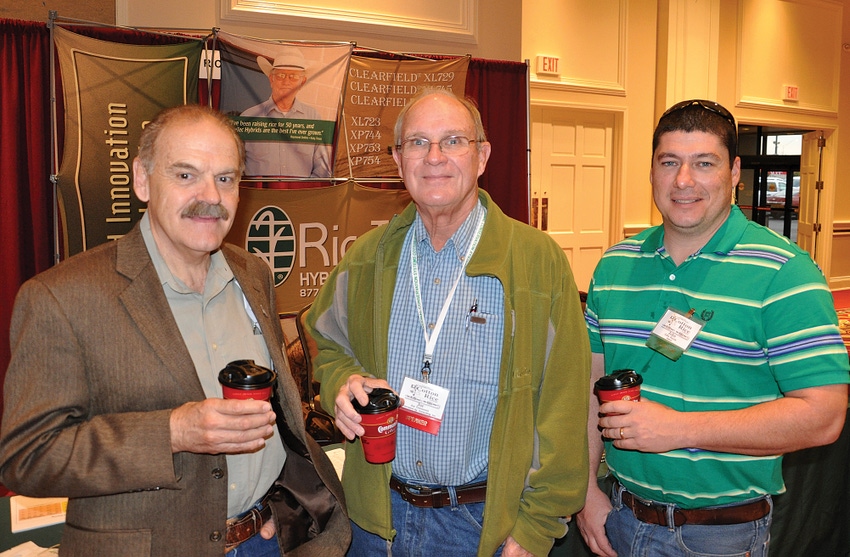
Fungicide resistance in the pathogen that causes shealth blight in rice has left many Louisiana rice producers with fewer options for control.A Section 18 emergency exemption for Sercadis fungicide, which has activity on sheath blight, will help.The resistant strain has been spreading quickly, adding to the concern.

When rice producers around Mowata, La., in Acadia Parish started seeing poor control of sheath blight with strobilurin fungicides a couple of years ago, researchers first looked at the usual suspects, sources of fungicides, application timing and methods, additives, water quality and unusual weather patterns.
When none of these factors could be linked to consistently poor fungicide performance, researchers and Syngenta, which markets fungicides used to control sheath blight in rice, looked closer at the disease itself, caused by the pathogen Rhizoctonia solani.
Testing confirmed that the samples from the infected fields, as well as samples of soybeans with aerial blight (which is also caused by Rhizoctonia solani), were at least 10 times more tolerant of azoxystrobin fungicide than isolates collected before strobilurin fungicides were commercially available, and from nearby fields in which the fungicides remained effective.
Azoxystrobin is the active ingredient in Quadris fungicide and one of the two active ingredients in Quilt fungicides. Azoxystrobin-resistant isolates were also resistant to trifloxystrobin, the active ingredient of Gem and one of two active ingredients of Stratego fungicide.
With few other options available, in 2012, a Section 18 emergency exemption for the use of Sercadis (fluxapyroxad), from BASF, which is highly effective again sheath blight, was granted for Arcadia, Vermillion, Jefferson Davis, Evangeline and St. Landry parishes.
It does go to show, disease control in southern climates can be quite unpredictable.
“For at least 15 years, application of respiratory-inhibitor fungicides azoxystrobin and trifloxystrobin have been the major control method for sheath blight, which is the most important disease of rice in the southern United States,” said Don Groth, plant pathologist, LSU AgCenter.
“The consensus had been that fungicide resistance in Rhizoctonia solani would not develop or would be slow to develop because traditionally, only one fungicide application was made per season.
“Also Rhizoctonia solani reproduces asexually, and populations may therefore be less genetically diverse than those of a sexually reproducing pathogen.”
Groth, speaking at the Conservations Systems Cotton and Rice Conference in Baton Rouge, La., said that increased use of strobilurin fungicides after the 2006 epidemic of narrow brown leaf spot (Cercospora janseana) in rice and the new threat of Asian soybean rust in soybeans, “increasingly challenged” Rhizoctonia solani populations. Resistance quickly developed and spread causing rice farmers in affected areas to lose a major tool for sheath blight control.
“Once you have resistance to one of the strobilurins, you have resistance to all of the strobilurins,” Groth said. “So we lost Quadris, Quilt, Quilt Excel, Gem and Stratego, and Headline in soybeans when it comes to this particular Rhizoctonia solani population.”
Groth noted that other fungicides, such as propiconazole, flutolanil and iprodione, are labeled for sheath blight control, but they are not effective enough to help manage resistance to fungicides.
“This means growers must rely on partial host resistance and cultural management to control sheath blight in rice and aerial blight in soybeans,” Groth said. “This will include use of less susceptible varieties, lower nitrogen and seeding rates, and inoculum-reducing practices such as rotation, cultivation, and sanitation.”
Sheath blight inoculum can survive five years to 10 years in the soil, “but fresh inoculum is a lot more active than older inoculums,” Groth said. “Do what you can to reduce the amount of inoculum going in the field. We also recommend treating sheath blight inoculum like organic matter. Anything that breaks down organic matter will break down sheath blight inoculum.”
Crawfish fields may help reduce inoculum, “because crawfish will clear-cut the rice straw.”
Burning fields may also help reduce inoculum.
“If you suspect you have the problem, you don’t want to move plant material or equipment from that field to another,” Groth added.
While growers often push rice to get better yields, Groth stresses that excessive nitrogen will produce more disease.
Groth noted that newer rice varieties have more tolerance to resistant sheath blight. “In Cypress and Cocodrie, we’re losing 25 percent to 35 percent in yield, the newer varieties we’re only losing 15 percent to 17 percent.”
Groth said he was surprised at how far resistant Rhizoctonia solani has spread from where it was discovered in Mowata, considering that it is a soil-borne disease. “We discovered it two years ago, but it may have been around for as much as five years.”
The maximum rate of Sercadis for the emergency exemption was 4.5 ounces per acre, noted Groth. “We put it out at late boot, which gave us very good activity and kept the sheath blight off the upper canopy. We got a good yield and milling increase. It’s definitely going to be a tool we can use.”
Louisiana has applied for a Section 18 for Sercadis for the 2013 season, according to Groth. The chemical for Sercadis is also an ingredient in the soybean fungicide Priaxor that is used on soybeans against aerial blight disease.
Samples of Rhizoctonia solani tested by Syngenta indicated that a change in one amino acid caused the resistance.
About the Author(s)
You May Also Like





